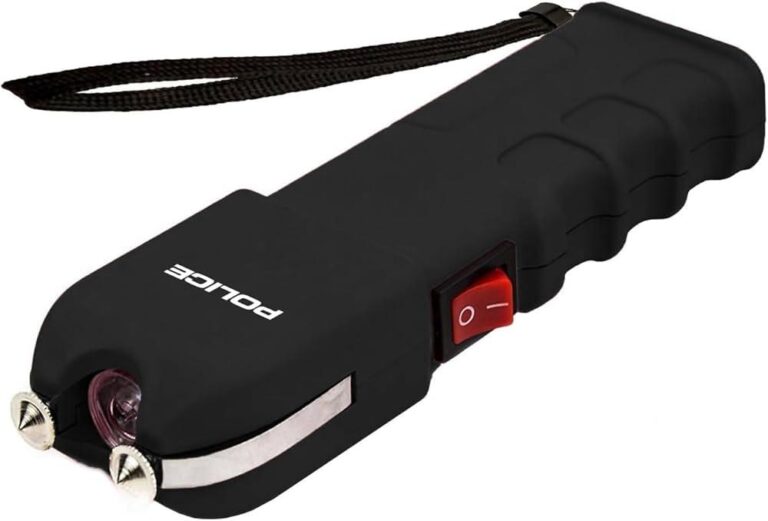Table of Contents
- Choosing the Right Stun Gun for Your Safety Needs
- Mastering Proper Grip and Stance for Maximum Control
- Techniques for Accurate Targeting Under Pressure
- Essential Maintenance and Safety Practices to Ensure Reliability
- The Conclusion
Choosing the Right Stun Gun for Your Safety Needs
When it comes to personal defense, selecting a stun gun that aligns with your specific safety requirements is essential. Consider factors such as size and weight for ease of carry, especially if you need something discreet yet powerful. Battery life and recharge options play a critical role in ensuring your device is always ready when you need it most. Additionally, look for models with multiple safety mechanisms like finger guards or safety switches to prevent accidental discharge, giving you confidence without compromising on quick accessibility.
Another key aspect involves understanding the range and voltage capabilities suitable for your environment. High voltage outputs can offer effective deterrence, but balance this with usability and local regulations governing stun gun power levels. Features such as built-in flashlights or alarms can enhance situational awareness during an emergency. Here’s a quick checklist to refine your choice:
- Compact design for comfortable carrying
- Reliable battery life with easy charging options
- Safety features to prevent accidental use
- Legal compliance based on your location
- Additional features like illumination or alarm functions
Mastering Proper Grip and Stance for Maximum Control
Achieving maximum control with a stun gun starts with understanding the importance of a firm yet comfortable grip. Ensure your hand fully wraps around the device, with your thumb resting on the activation button for quick access. Avoid holding it too tightly, as tension can cause unnecessary shake and reduce accuracy. Instead, maintain a balanced grip that stabilizes the stun gun whilst enabling swift maneuverability. Your fingers should support the body of the device securely, preventing slips during high-stress situations where precision is crucial for effectiveness and safety.
Equally essential is adopting a stance that enhances stability and quick response. Position your feet shoulder-width apart, with your dominant foot slightly forward to improve balance and mobility. Keep your knees slightly bent to absorb movement and allow for rapid adjustments. Incorporate these key points for an optimal stance:
- Maintain a low center of gravity: Keeps you grounded and reduces the risk of being pushed off balance.
- Keep your arms relaxed but ready: Tension can lead to fatigue, so stay calm while staying alert.
- Face your target squarely: Ensures your aim is consistent and effective under pressure.
Techniques for Accurate Targeting Under Pressure
When every second counts, maintaining composure is paramount. One key method is to engage your breathing-take a deep breath before aiming, as steady breaths help stabilize your hands and sharpen focus. Additionally, focus your eyes on a specific target area rather than the whole threat; this laser-like concentration minimizes distractions and improves precision. Training your muscle memory through regular practice with your stun gun can also help the body react instinctively, even when adrenaline is high.
Another vital strategy is to adopt a firm yet flexible grip, ensuring control without tension that can cause shakiness. Practicing targeting by visualizing or simulating pressure scenarios allows you to familiarize yourself with common stress pitfalls. To help lock in accuracy under stress, consider these techniques:
- Use small, deliberate trigger pulls instead of fast, uncontrolled presses.
- Maintain a balanced stance to reduce body sway or movement.
- Train peripheral awareness to avoid tunnel vision and adapt quickly.
Essential Maintenance and Safety Practices to Ensure Reliability
Maintaining your stun gun in optimal condition is critical to ensure it functions effectively during high-pressure situations. Regular checks on the battery life and electrode tips should become part of your routine, as worn-out batteries or damaged contacts can severely compromise the device’s reliability. To extend battery life, avoid leaving the stun gun plugged in continuously and perform monthly test discharges, following manufacturer guidelines. Always store your device in a dry, cool place free from dust buildup to prevent corrosion or short-circuiting of internal components.
Safety protocols are equally important to prevent accidents or device malfunctions. Before each use, familiarize yourself thoroughly with your stun gun’s safety lock and activation buttons to reduce accidental deployment risk. When handling or demonstrating the device, keep it pointed away from yourself and others, and never test it on sensitive areas such as the head or throat. Incorporate these habits into your training sessions and everyday carry routine:
- Secure storage: Always keep your stun gun in a holster or protective case.
- Regular cleaning: Use a soft cloth and isopropyl alcohol to clean the electrode areas.
- Periodic training: Practice deployment and safety drills under controlled conditions to build muscle memory.
The Conclusion
In high-stress moments, effectively using a stun gun can make all the difference in ensuring your safety. By staying calm, understanding your device, and practicing proper techniques, you empower yourself to respond confidently when it matters most. Remember, preparation and knowledge are your best tools-equip yourself with both to handle any situation with clarity and control. Stay safe and be smart!Check Our Other Blogs
- StunGun – Your Trusted Source for Stun Guns, Laws, and Self-Defense Tips
- PepperSprayLaws – Your Trusted Resource for Pepper Spray Information
- StunGunLaws – Your Trusted Guide to Stun Gun Legality and Safety





